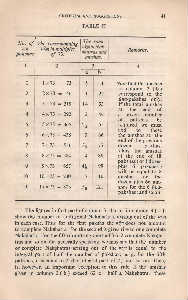Page 689 - Lokmanya Tilak Samagra (khand 2)
P. 689
CRITICISM AND SUGGESTIONS 41
TABLE II
The corresponding I-~· s~mz
No. of
1
QiOf ~~ in multiples .. '< '1 tm a d- Remarks.
1 ras an
pakshas of 73 . . ~ 1a
amshas.
1
1 2 3 4
a I b
1 1 X73 = 73 t I 11 Note that the amshas
in column 3 ( b )
2 2 x 73 = 146 22 correspond to the
una-pakshas only.
3 3 x 73 = 219 I ~ 33 If the total amshas
at the end of
4 4 x 73 = 292 2 44 a given number
of pakshas be
5 5 X73 = 365 21 55 required, we must
add to these
6 6 X73 = 438 3 66 the amshas at the
end of the previous
7 7 X73=511 3t 77 dozen pakhas.
Thus the amshas
8 8 X73 = 584 4 88 at the end of 18
pakshas (or 1 dozen
9 9 X 73 = 657 41 99 plus 6 pakshas )
will be equal to 8
10 10 X 73 = 730 5 110 amshas for the
dozen plus 66 am-
11 11 X73 = 803 5i 121 shas for the 6 una-
pakshas; and so on.
The figures in first part of column 3, that is in column 3 (a),
show the number of additional Nak~hatras, arising out of the ~~
in each case. Thus for the first paksha the~ does not amount
to complete Nak~hatra ; for the second it gives rise to one complete
Nak~hatra; for the fifth (omitting one half) to 2 complete Nak~ha
tras and so on. Or, generally speaking, we may say that the number
of complete Nak~hatras arising out of the ~~ is equal to the
integral part of half the number of pakshas; e. g. for the fifth
pakshas, it is equal to 2, the integral part of 2; and so on. There
is, however, an important exception to this rule. If the amshas
given in column 3 ( b ) exceed 62 or half a Nak~hatra, these

